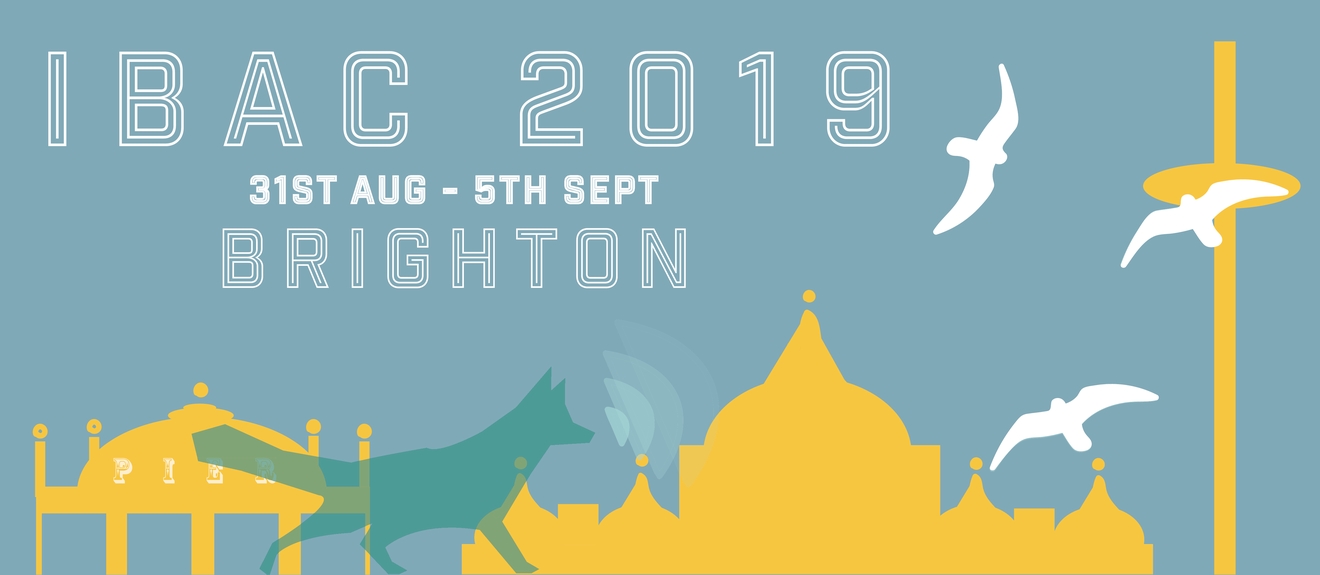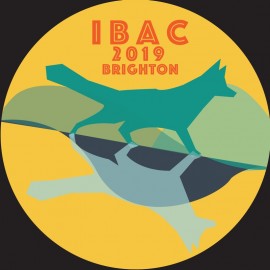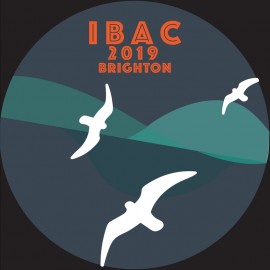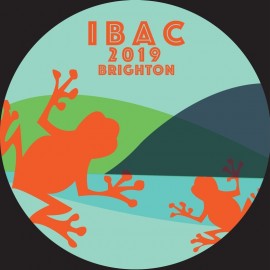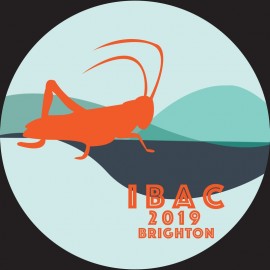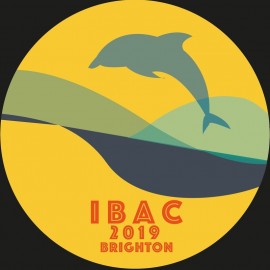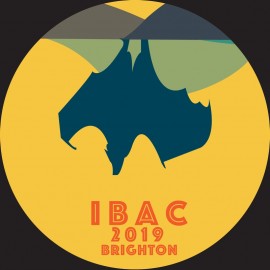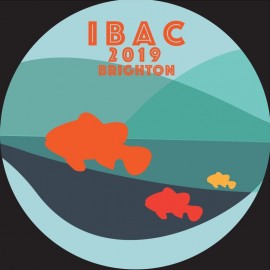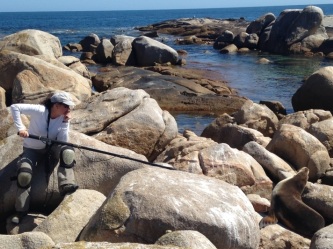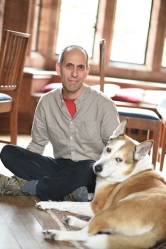Programme
Conference Programme and Timetable
Access the most up-to-date version of the Conference Programme Booklet.
You can also now view the full list of oral and poster presentation abstracts in the most recent version of the Abstract Booklet.
The timetable can be downloaded here.
This is for information only, subject to change until the publication of the final programme in August 2019.
| TIME |
DAY 1 |
DAY 2 |
DAY 3 |
DAY 4 |
DAY 5 |
DAY 6 |
|---|---|---|---|---|---|---|
| 09:00-09.30 |
Registration 1 |
Greg Bryant | Arik Kershenbaum | Katharina Riebel | 9.15 start Sex and Size |
|
| 09:30-10.00 | ||||||
| 10:00 -10.30 | Coffee Break | Coffee Break | Coffee Break | Coffee Break | Coffee Break | |
| 10:30-11.00 | Rhythm & Timing |
Development of Audition & Vocal Learning |
From Lab to Field 2 |
Anthropogenic Noise |
General Session 2 |
|
| 11:00-11.30 | Welcome | |||||
| 11:30-12.00 | Isabelle Charrier |
General Assembly |
||||
| 12:00-12.30 | ||||||
| 12:30-13.30 | LUNCH | LUNCH | LUNCH | LUNCH | LUNCH | LUNCH |
| 13:30-14.00 | General Session 1 |
Cultural & Geographic Song Variation |
1.30 depart
|
Strategies of Information Coding |
||
| 14:00-14.30 | ||||||
| 14:30-15.00 | ||||||
| 15:00-15.30 | ||||||
| 15:30-16.00 | Coffee Break | Coffee Break | Coffee Break | Coffee Break | Coffee Break | |
| 16:00-16.30 | Vocal Expression of Emotions |
Social Networks |
From Lab to Field 1 |
Advanced Computational Methods |
Cetacean Bioacoustics |
|
| 16:30-17.00 | ||||||
| 17:00-17.30 | ||||||
| 17:30-18.00 | Closing | |||||
| 18:00-18.30 |
free time |
free time | ||||
| 18:30-19.00 | Welcome Reception |
Poster session (Wine & Cheese) |
||||
| 19:00-20.00 | Pub Crawl | Gala dinner & Awards2 |
||||
| EVE... |
| Colour codes: | Break | Assembly | Talk session | Social event | Excursion | Plenary |
Notes:
- Posters to be put up throughout the conference (hung on Day 1, taken down on Day 6)
- Awards will be given for
- Best sound recording
- Craziest spectrogram
- Outstanding poster Sponsored by Taylor and Francis
- Outstanding talk by early career scientist (PhDs and postdocs) Sponsored by PeerJ
"Conferences" is the University of Sussex's special conference wifi network, check the FAQ for help. It can be accessed with the following passwords:
From 27 August 2019 - 02 September: threaten her pastel partridge
From 03 September 2019 - 9th September: mutter a vibrant quiet
Alternatively, Eduroam is also available for those with log-ins from their own institutes.
Plenary Speakers
|
Recognition systems and Social structure in Pinnipeds 11:30am Saturday 31st August In many species, parents and offspring have developed the ability to vocally identify each other. In bird species, experimental works put in obviousness a strong relationship between individual recognition system and social structure, with recognition systems being more elaborated in species exposed to strong selective pressures (e.g., colonial species vs solitary species). Pinnipeds (seals, fur seals, sea lions and walrus) are an excellent mammalian clade model for comparative studies of individual vocal recognition as their social structures and breeding systems show a great diversity and they use vocalisations in all their social interactions. The study of mother-pup vocal recognition systems demonstrates some clear evidence that pinniped species with the highest selective pressures for mother-pup recognition have developed the most complex recognition system. Indeed, such species show a high index of vocal stereotypy (IVS), a rapid onset of vocal recognition, a multi-parametric vocal signature mainly based on temporal analysis whereas species living in less constraining environments show a moderate to low IVS, a delayed onset of vocal recognition, a multi-parametric signature mainly based on a frequency analysis. Understanding how ecological and social constraints shape communication systems in vertebrates is essential. Our current knowledge on different taxa show that species encountering similar constraints for individual recognition has developed similar communication systems, suggesting common communication rules in Vertebrates. Isabelle Charrier is a French senior researcher at CNRS (National Center for Scientific Research) co-leader of “Acoustic Communications” the team at the Paris-Saclay Institute of Neuroscience. Isabelle has made an outstanding contribution to the field for marine bioacoustics. She studies vocal communication in a wide range of marine species (pinnipeds, cetaceans and seabirds) with a special focus on Pinnipeds (seal, fur seals, sea lions and walrus). She is interested in the recognition processes developed by mothers and their offspring, but also the vocal assessment and social communication networks in males. Most of the work involved field experiments and behavioural observations of animals in their natural environment. Isabelle works in different parts of the World (Arctic, Antarctic, Australia, Canada, Greece, Madagascar, USA) and in collaboration with international colleagues. |
|
The evolution of human laughter 9:00am Sunday 1st September Laughter is a ubiquitous nonverbal affective vocal signal that manifests itself universally across cultures. Human laughter is homologous with play vocalizations across mammalian species, and likely retains this conserved play function. But laughter in humans has unique features as well, suggesting a suite of species-specific communicative functions assimilated with language use and sophisticated social cognition. In this talk I will describe several lines of research from my lab over the last decade exploring the psychoacoustics of laughter, cross-cultural universals and variations in laughter perception, and the role of laughter in everyday conversation. Laughter provides a unique window into human vocal signaling and cooperative behavior, as well as an example of how ancestral communicative behaviors become integrated with later evolving systems. Greg Bryant is a Professor and Vice Chair in the Department of Communication at the University of California, Los Angeles. Greg is a leading researcher in human vocal communication and social behaviour, including examining the mechanisms and evolutionary underpinnings of laughter, infant directed speech, and vocal communication of emotion. As a pioneer in cross-cultural perception studies, his research often involves large, representative samples of participants from around the world. |
|
Alien logograms, wolf howls, and dolphin whistles: Are we looking for information in the right places? 9:00am Monday 2nd September Understanding animal vocal communication is a research goal that is inextricably linked with our quest for the understanding of the evolution of human language. While making such a connection is understandable, we must not forget that animals have evolved their own communicative strategies for their own fitness benefits, which in general do not include linguistic proficiency. Our desire to see the origins of human language in animal communication can potentially have some unwanted consequences. In particular, while many animals do indeed communicate using a sequence of discrete acoustic symbols (similar to human language), many species encode information in other ways: varying the timing or rhythm of their sounds, or producing a signal consisting of continuous variation, rather than discrete units. Sometimes, our desire to see temporal sequences of discrete symbols prevents us from objectively assessing whether a particular signal is in fact continuous, rather than discrete. The recent Hollywood blockbuster “Arrival” presented the fictional example of an alien species with a linguistic system that could not be decoded without a radical change of perspective in how we view communicative signals. I am not proposing that animals vocal communication hides a secret language inside an encoding we have not yet considered. Neither am I merely suggesting that our perspective on animal communication must be broadened to consider a wider range of possibilities of information encoding processes. I am suggesting that our very understanding of animal communicative “meaning” should be reconsidered to account for the fact that most animal vocal communication is (unlike language) not evolutionarily optimised for efficient information encoding. Rather, communicative signals represent a trade off between such a wide range of fitness factors, that saying that a particular signal “means” a particular message, may not be the most helpful paradigm for animal vocal researchers. I will illustrate these ideas with examples from my own work on meaning in wolf howls, and information in dolphin whistles, as well as consideration of the implications for the decoding of alien communicative messages, should we ever receive any. Arik Kershenbaum is a zoologist, College Lecturer, and Fellow at Girton College, University of Cambridge. Arik’s contributions to the field of sequence analysis have been particularly impactful. He received his PhD at the University of Haifa in Israel, where he studied the complex communication of the rock hyrax, demonstrating the sophisticated syntax of their bird-like songs. He has since concentrated on vocal communication in wolves and dolphins, looking at how their howls and whistles are used to convey specific information about the world around them. After a postdoctoral fellowship at the National Institute for Mathematical and Biological Synthesis in the USA, Dr Kershenbaum became interested in the less familiar ways that animals encode information in their signals, and what alternatives might exist to the word-sentence approach with which we are familiar from human language. He was Herchel Smith Research Fellow in Zoology at the University of Cambridge, before taking up his position at Girton College. He is also a member of the international board of advisors for METI.org, a think tank on the topic of Messaging Extra Terrestrial Intelligence. |
|
Peter Narins Departments of Integrative Biology & Physiology, and Ecology & Evolutionary Biology, UCLA The Puerto Rican Coqui: An exemplary model for acoustic communication in noise. 9:00am Tuesday 3rd September In this talk, I shall discuss the responses of the Puerto Rican Coqui to playbacks of acoustic stimuli and what we can learn from them. For example, presenting high-level, periodic tones to vocalizing males in their natural habitat results in a clear shift in their calling pattern in that they avoid acoustic overlap with the playback stimulus. In addition, in response to aperiodic interfering tones, males of this species initiate their calls in the gaps between the interfering tones more often than would be expected by chance alone. The Coqui also have a remarkable ability to shift their call timing in response to small intensity shifts in the background noise. Moreover, these animals exhibit several novel adaptations to reduce the potentially deleterious effects of their high-intensity calls on their own auditory system. Clearly this species represents a remarkable model for understanding acoustic communication in high levels of background noise and deserves widespread conservation efforts (Support: UCLA Acad. Sen. grants). Peter Narins has carried out pioneering studies in auditory and seismic sensory neuroethology. He discovered the first example of sexual dimorphism in a vertebrate sensory system. Moreover, he demonstrated phase-locking in the auditory nerve of amphibians and used it to provide evidence for the extraordinary seismic sensitivity of the amphibian inner ear. Narins discovered that a highly territorial South American dendrobatid frog uses a combination of acoustic cues (advertisement calls) and visual signals (vocal-sac pulsations) to repel conspecific intruders. He developed a robotic frog to demonstrate that aggressive behaviour can be elicited only when both signals are presented simultaneously (temporal binding) and at particular spatial orientations (spatial binding). Narins and colleagues (a) discovered several Chinese torrent frogs produce and detect calls containing ultrasonic harmonics and that a distantly related Bornean frog communicates entirely in the ultrasonic range; (b) revealed that the functionally blind Namib golden mole relies solely on seismic cues to locate food sources; and more recently (c) demonstrated that the vibrational component alone of a Guyanese frog’s call is sufficient to alter calling behaviour and direct movement of neighbouring vocalizing frogs. Narins’ original, groundbreaking field studies and correlated seismic and auditory physiological investigations have profoundly altered our understanding of how terrestrial vertebrates perceive their world. |
|
Perspectives on female bird song learning - towards an inclusive study of male and female communication roles 9:00am Wednesday 4th September Bird song is a prime example of a culturally transmitted trait. In most song birds, song is learned early in life from conspecific models. Song has long been considered a predominantly male trait: males sing to attract females and females drive the evolution of signal exaggeration by preferring males with ever more complex songs. This view has emphasized the stark sex differences common in some, but not all biogeographic regions and has biased the research on cultural transmission towards male song learning. However, even in species where females do not sing at all, females memorise song when young, and these early experiences shape their adult song preferences. Using our experimental work in zebra finches, a species with non-singing females, I will show how different developmental factors affect female preference development. I will place these empirical insights in the broader context of recent findings and analyses showing that female song not only is widespread but concurrent male and female song the most likely ancestral state. I will discuss the type of questions of interest to future work that aim towards a more inclusive approach studying male and female communication roles in concert. Katharina Riebel investigates causes and consequences of condition and learning dependent phenotypic variation in sexually selected traits and preference at Leiden University. Her current research interests focus on improving our understanding of developmental processes that contribute to such variation, namely sensory learning and state dependency of choice (full bio to follow). |
Symposia:
Vocal communication in Social Networks (Manfred Gahr)
Reviewing how and why animals communicate by sounds within networks, and how constraints and needs related to different ways of group living or different social environments shape vocal communication.
Strategies of information coding (Thierry Aubin & Nicolas Mathevon)
Reviewing several questions related to information coding in acoustic signals, such as: which code for which information, which code for which environment, which code for which social life.
Rhythm and timing in animal vocal communication (Andrea Ravignani & Maxime Garcia)
Providing a common platform for researchers from a range of fields to compare theoretical approaches and methodologies; and discussing and integrating ideas and findings from evolutionary, behavioural and cognitive approaches.
Vocal expression of emotions (Elodie Mandel-Briefer, Céline Tallet, & Avelyne Villain)
Exploring how emotional arousal and valence can be expressed in vocalisations, how this can affect animal welfare monitoring, and how they should be classified.
Analysing acoustic communication - common perspectives across species (Daria Valente & Julia Jenikejew)
Pooling the insights on vocal communication and its analysis in various species, and by doing so provide the first steps on the way to establish a common ground for the approaches and concepts of bioacoustics methods.
From the lab to the field 1&2: integrating bioacoustics and ecoacoustics (Ed Baker, Tomás Rostirolla, & Klaus Riede)
Reviewing the state of the art of ecoacoustics and bioacoustics and proposing greater collaboration between researchers working on single species with those operating on the ecosystem level.
Underwater acoustics: soundscapes across different scales (Frédéric Bertucci & Maria Clara P. Amorim)
Reviewing current aquatic and marine bioacoustics research, focusing on interactions between living organisms and between organisms and their environment in relation to the evolution of underwater ecosystems
Development of audition and vocal learning (Mylene Mariette)
Revealing what acoustic signals developing animals can perceive, including before birth, and exploring the ontogeny of sound production and vocal learning across taxa and environments
Social Events
|
On Saturday 31st August, we are pleased to announce there will be a Welcome Reception for all conference attendees. The entertainment will be provided by Brighton Morris Men. The event will begin at 7pm at Falmer Bar. (Further details to follow.) |
|
On Sunday 1st September, there will be a Pub Crawl through Brighton in the evening. This list can also be downloaded as a PDF here. The Hanover trail: Hanover, also known as the “Muesli mountain” is a lovely residential area that boasts some of the most convivial and interesting pubs in Brighton. This hilly trail will leave you out of breath!
Only time for a couple? We suggest 1. Haus on the Hill & 7. The Constant Service. Pubs Info: https://goo.gl/maps/yPnXPjMMaBnJtM6d8 Trail Map: https://goo.gl/maps/akVFuWNFnHfajp3M8
The Rock & Roll trail: These very atmospheric pubs double as live venues and have seen the rise of so many musical talents. If you love indie music and are not looking for quiet - this one is for you!
Only time for a couple? We suggest you just go to 3. The Prince Albert and 4. Hope and Ruin. Pubs Info: https://goo.gl/maps/FDXYoKtz1Y7ryXov8 Trail Map: https://goo.gl/maps/JfGmwEDQKbQMz9BH7
The North Laine trail: Enjoy Brighton’s most characterful pubs at the hipster heart of the hipsterest city in the world (… or at least in the UK). These pubs are small so be ready to compete for space with local hipsters.
Only time for a couple? We suggest you go to 3. The Basketmakers & 5. The Great Eastern. Pubs Info: https://goo.gl/maps/85YeoWbXDkCAzQsm9 Trail Map: https://goo.gl/maps/BqBd5P1zdJvidNSj9
The Craft Beer Trail: If you feel like hopping around to assess local IBUs, here’s a selection of pubs that will entertain your tastebuds:
Only time for a couple? Skip number 1. North Laine Brewery, small groups head for 3. Bison Beer, large groups aim for 2. Brewdog. Do not miss 4. Bierhaus under any circumstance. The “Hove, actually” trail: Why “actually”? Don’t use your smartphone and ask a local if you can find one. (By the way, don’t bother checking your phone AT ALL in the Gin Tub, the entire bar is enclosed in a Faraday Cage that blocks mobile signals to reignite the art of conversation).
Time for only a few? If it’s early we recommend 1. Hove Place through 3. Gin Tub, if it’s late, just head to the final destination at Bees Mouth! |
|
Programing environmental music with an augmented sustainable instrument - a musical concert by Netherlands Coding Live On Monday 2nd September, there will be a performance by the musical group Netherlands Coding Live in the Jubilee Lecture Theatre starting at 6pm. It will last 30 minutes approximately and be followed by the evening Poster Session with Wine & Cheese. Netherlands Coding Live describe the experience: "This concert is a combination between the analogue and the digital world of environmental music where an augmented instrument and a computer were designed to generate trigger sounds of Sussex's nature based on loops and iteration. We use the concept of circular music generation to integrate the material itself, streaming the available energy sources (plants, animals, rocks, earth and water). Ambient or environmental music is a genre of music that emphasizes tone and atmosphere over traditional musical structure or rhythm. "At this concert, a duo composed by Rafaele Andrade (Brazil) and Sebastian Pappalardo (Argentina) will guide musical structures that are manipulated with their musical instruments build/programmed by themselves. We improve the idea of repetition, interaction and improvisation, combining it by triggers, event or tasks. Therefore, those musical concepts won't contain hierarchised methods of time definition. On this concert, time is part of a natural flow of exchange energy sources, an experience that is the most remarkable of live environmental code music." This is a free event open to all interested parties. |
|
Excursion to Petworth Park - £25 (tickets available, please go to Info Desk for assistance) On Tuesday 3rd September, there will be an excursion to beautiful Petworth Park in Sussex. This National Trust property is a 17th century house surrounded by a 700 acre park designed by the famous landscaper, Capability Brown, home to more than 900 fallow deer. There is also a pleasure garden, with a wooded walk. For art lovers, there are paintings by Turner, Van Deck, Reynolds, Titian, and Blake, and classical and neoclassical sculptures. The Park offers a restaurant and coffee shop with a range of options as well as a shop selling gifts. The trip will be by coach from Falmer Campus from approximately 13:30 on Tuesday and will leave the park at 18:00, with an expected arrival back to campus by 19:00. The price is £25 per person, including coach travel. We will meet outside the Jubilee building at 1.15pm and walk to the coach. (The organisers cannot be held responsible for any personal accident or damage to personal property during the excursion. The organisers strongly urge participants to ensure they have adequate travel and personal insurance cover before they join the excursion.)
|
|
Gala Dinner at the Brighton Metropole Hotel - £48 (SOLD OUT) On Wednesday 4th September, there will be a Conference Dinner open to all attendees. This dinner will take place at the Brighton Metropole Hotel on the seafront near the i360 and the (pebble) beach from 19.00 onwards. This will be a three-course meal with an arrival drink, 1/2 bottle of house wine, and a choice of tea or coffee. Please arrive from 19.00 and be ready to take your seat at 19.45. Please make your own way to the Hilton Metropole and there will be staff to greet you. We are in the Clarence Room which will be signposted. Contact the organisers if you require assistance. The address of the hotel is Hilton Brighton Metropole, Kings Rd, Brighton BN1 2FU. There will be an arrival drink followed by a three-course meal with 1/2 a bottle of wine per head, and a DJ, music, and dancing from 22.00.
|
